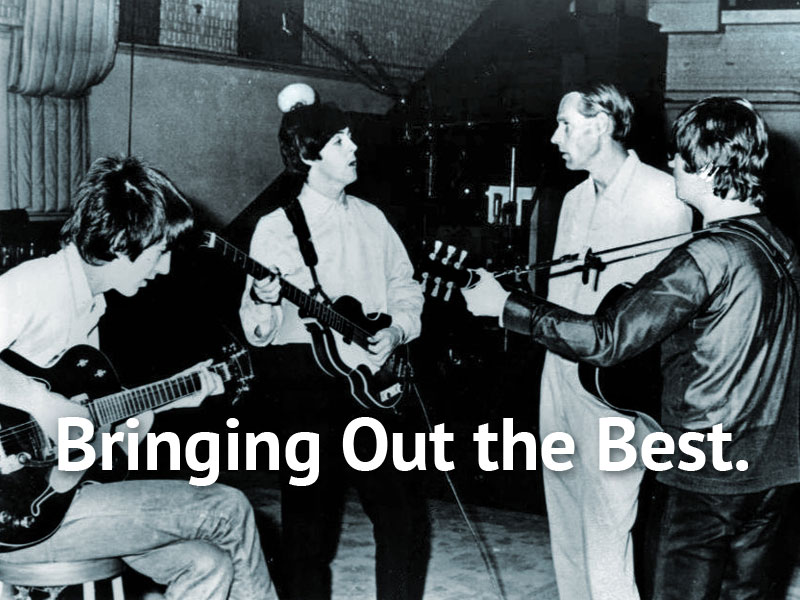How George Martin helped The Beatles change the world.
The music industry lost a true pioneer on March 8, 2016. Sir George Martin died after a widely celebrated career at the age of 90. An artist and producer with a successful track record in his own right, Martin was most renowned for his work with The Beatles between 1962 and 1970.
Many don’t know it, but Martin didn’t even want to work with the pre-Ringo Beatles when they first ventured into his studio in June of 1962. At the time, he saw a band pushing unpolished material, a drummer who couldn’t hold a steady beat and four young men who were still pretty rough around the edges.
But, in John Lennon, Paul McCartney and George Harrison, Martin also saw something that other groups of the time lacked. In fact, the concept of a rock “group” was foreign to the current industry. Every pop music act at the time was “Someone and the Somethings.” It was always a singer and a backup band. But, these guys were different. Three of them sang! They wrote their own material and played their own instruments! And they had engaging personalities that transcended their jittery auditions.
While many credit Brian Epstein, their passionate manager, with cleaning them up and adding professionalism to their act, it was Martin who became vital to their creative growth as artists. They had the vision. He had the musical background and production expertise to make it happen. There are numerous stories of how John or Paul entered the studio with a basic song and clear idea of what they wanted to make of it. They had lofty expectations of themselves, yet never saw insurmountable barriers toward reaching them. There was no stopping them.
They simply needed enablers.
George Martin and his studio engineers bridged the gap between grand aspirations and the reality of making hit records. Technologies and techniques were literally invented to fulfill The Beatles’ insatiable drive to become what they called, “The toppermost of the poppermost!” New ground was broken time after time. Before long, The Beatles just knew they could create something profound because they fully expected their studio team to deliver the means of attaining it. And, in doing so, they all made history together.
That’s the reason why George Martin is universally regarded as, “The Fifth Beatle.”
So, what’s the marketing story here and why does it matter?
Greatness cannot be achieved within a vacuum. It takes vision, perseverance and a team of experts to make it happen. It requires an understanding of what your audience wants, even if it’s something that doesn’t quite exist. You aim high, learn from your failures (and The Beatles had their share along the way) and never say, “It can’t be done.” And, you continually set great expectations of yourself and uncover ways to meet them.
Look at what The Beatles accomplished in eight short years. We’re still talking about them and singing their songs nearly five decades after their break-up.
Without someone like George Martin in their corner saying, “Yes,” no matter how outlandish the request may have seemed, it’s not unreasonable to think that The Beatles might have given up before breaking through. And they would not have changed the world.
Many businesses find themselves in the same position as those budding musicians. They are motivated, have great ideas and see a bright future, if only someone can help them realize it. Remember, you simply cannot do it all by yourself. It’s essential that you surround yourself with strategic and creative enablers who can help you reach your dreams. You might not change the world like the Fab Four did. But, there’s no reason why you can’t gain yourself a few chart-toppers . . . with a little help from your friends.
Related Posts
What do you want your business to look like five years from now?
If your brand cannot adapt to change, you could end up burning cycles recovering what you lost instead of spending your time building on what you have. As Ben Franklin once put it, “An ounce of prevention is worth a pound of cure.”
The one thing we all share and what to do with it
Even if you’re selling widgets, there’s something more than you offer that distinguishes your business in a positive way. It’s what your customers truly gain from you that they can’t get from anyone else. This defines your business more than anything.
Startup branding needs to be done right out of the gate
The bankruptcy courts are full of great ideas that were undermined by ineffective branding and promotion. Build it and they will come? No, they won’t. Not unless you make them really want to. Or, better yet, need to.




